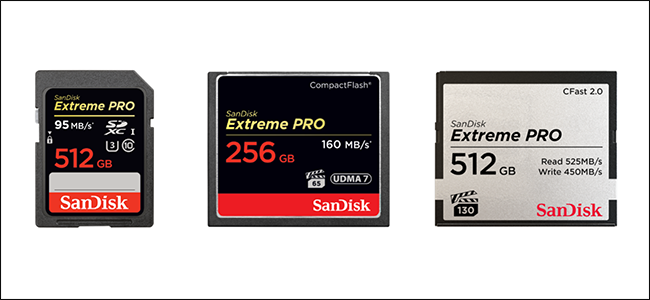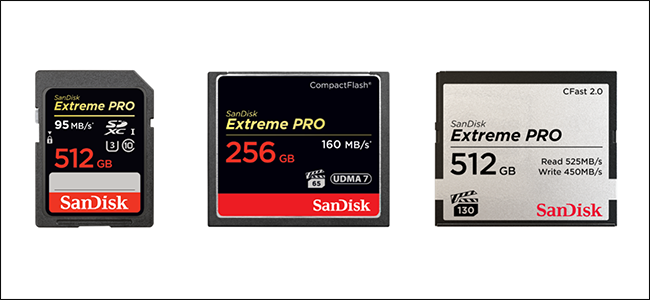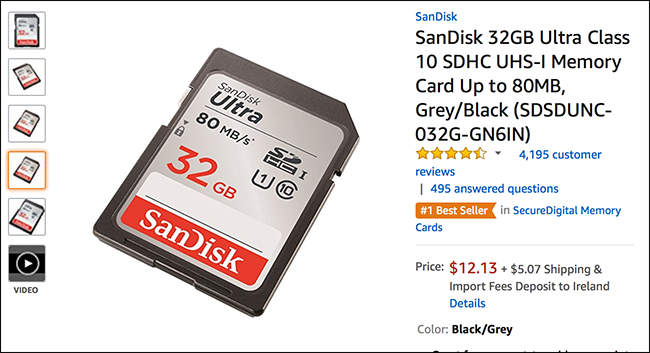Quick Links
Modern digital cameras all write the photos and videos you take to removable storage cards, but which ones do you need? Let's look at which SD cards---and CompactFlash, CFast, or XQD cards---are right for you.
Which Format Should You Buy?
The most important thing is to make sure you buy the right format card for your camera. There are four main form factors of card your camera could need:
- SD, SDHC cards, and SDXC cards
- CompactFlash cards
- CFast cards
- XQD cards
SD, SDHC, and SDXC cards (generally all just grouped as SD cards) are by far the most common; the vast majority of consumer digital cameras use them. SDHC (Secure Digital High Capacity) and SDXC (Secure Digital Xtra Capacity) are just newer versions of the SD (Secure Digital) standard that support larger storage capacities and faster processing speeds. If you're using a new-ish digital camera, the chances are it takes SD format cards, and it should support all three versions. If your camera is a bit older, check the manual. It may only support SD and SDHC---or if it's ancient, just SD cards.
Different professional cameras might use CompactFlash, CFast, and XQD cards. CFast and XQD are competing successors to CompactFlash although they're not backward compatible. It's pretty unlikely your camera needs one of these formats but if you're in doubt, check the manual or look at the card slots; they're almost always labeled in some way. If your camera does take one of these formats, it may also have a second SD card slot.
What Speed Card Should You Buy?
Not all storage cards are equally fast at reading or writing data. There are slower, cheaper cards for less intensive uses and super high speed, high-end professional options. What speed card you need depends on your camera.
The speed of SD cards is measured in classes. Classes 2, 4, and 6 are too slow if you're shooting RAW (and you should be). We consider 10/Ultra High Speed (UHS) Class 1 to be the sweet spot between speed and price. The faster UHS Class 3 cards are great if you're shooting lots of really high-resolution images or video, but are probably overkill for general use.
For CompactFlash cards, 120 MB/s is enough for all but the most intensive shooting. 160 MB/s cards are great, but at almost twice the price, not necessary for most people.
With CFast and XQD cards, the minimum speeds allowed by the standards are more than sufficient for photography and videography. It's only serious professionals and researchers who are going to push the cards anywhere near their limits.
What Capacity Card Should You Buy?
There are two schools of thought when it comes to what size storage cards to buy:
- The first is to buy a minimal number of big cards. This way, you rarely have to change cards, and you're less likely to lose them. We're talking 32 GB plus here, so that's thousands of photos per card.
- The second to buy a large number of smaller cards (typically around 8GB). This way, if a card gets corrupted or you lose it some other way, you only lose a small portion of your photos.
There are merits to both schools of thought, and you need to decide which is right for you. I prefer to use 32GB cards because I think losing a card while I travel is far more likely than the data getting corrupted. I also back the photos up to my computer and the cloud at every opportunity. On the other hand, if you're more concerned about data loss, then go with more smaller cards.
For videographers, the point is kind of moot. Video takes up so much space that you should buy as many of the largest cards you can afford as possible.
A Few Good Cards
There are dozens of no-name companies making storage cards, but when it comes to trusting something to store your precious photos, we'd recommend sticking to one of the big reputable manufacturers like SanDisk, Lexar, Transcend, and Kingston. Here's a non-exhaustive list of some of our favorite cards:
- SanDisk Ultra 32GB Class 10 SDHC ($12)
- SanDisk Extreme Pro 64GB UHS Class 1 SDXC ($33)
- SanDisk Extreme 32GB CompactFlash ($32)
- Lexar Professional 1066x 32GB CompactFlash ($45)
- Sandisk Extreme Pro 128 GB CFast ($340)
- Lexar Professional 2933x 32GB XQD ($100)
Your photographs are important, so it's worth spending just a bit more on a quality card.



